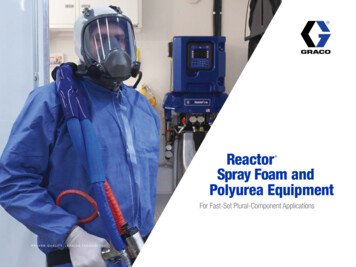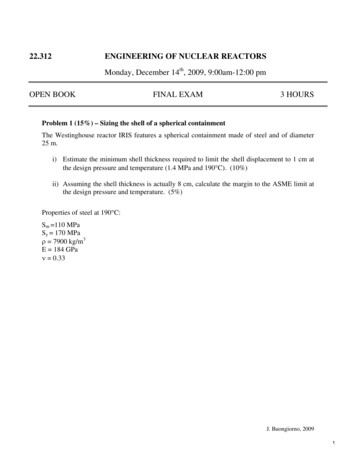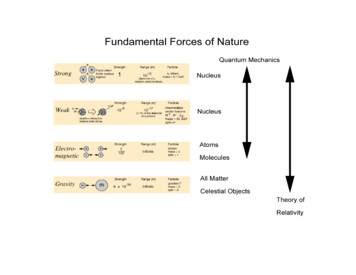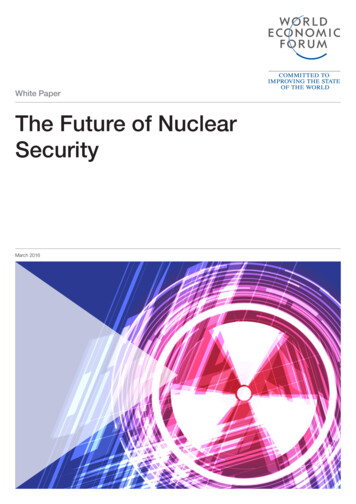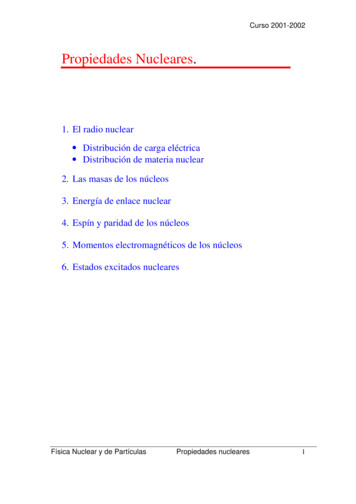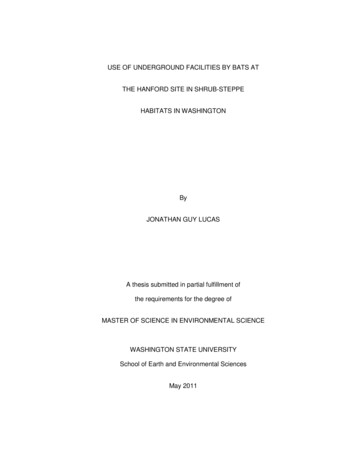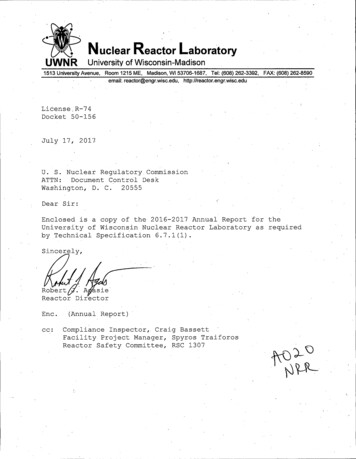
Transcription
Nuclear Reactor LaboratoryUWNRUniversity of Wisconsin-Madison1513 University Avenue,Room 1215 ME, Madison, WI 53706-1687, Tel: .(608) 262-3392, FAX: (608) 262-8590email: reactor@engr.wisc.edu, http://reactor.engr.wisc.eduLicense R-74Docket 50-156July 17, 2017U. S. Nuclear Regulatory CommissionATTN:Document Control DeskWashington, D. C.205 5Dear Sir:Enclosed is a copy of the 2016-2017 Annual Report for theUniversity of Wisconsin Nuclear Reactor Laboratory as requiredby Technical Specification 6.7.1(1).Sincerely,R(};;sieReactor DirectorEnc.cc:(Annual Report)Compliance Inspector, Craig BassettFacility Project Manager, Spyros TraiforosReactor Safety Committee, RSC 1307
''THE UNIVERSITY OF WISCONSINNUCLEAR REACTOR LABORATORYFISCAL YEAR 2016-2017 ANNUAL OPERATING REPORTPrepared to meet reporting requirements of:·u.S. Nuclear Regulatory CommissionLicense R-74Docket 50-156Technical Specification 6.7.1(1)Prepared by:Robert J. AgasieDepartment of Engineering PhysicsTHE UNIVERSITY---q/----WISCONSINMADISON··.·'
UWNR ANNUAL REPORT- Fiscal Year 2016-2017Page 1 of 16EXECUTIVE SUMMARY OF REACTOR UTILIZATIONInstruction:Instructional usage of the reactor during theyear included:82 Nuclear Engineering students inlaboratory and lecture courses.636 individuals from 18 organizations aspart of the UW Nuclear Reactor Outreach andCommunity Service Program.Research:Neutron irradiations during the year included:275 samples irradiated for departments atUW-Madison.12.21 MW-hr of irradiation time of ionchambers for nuclear heating measurements
, UWNR ANNUAL REPORT- Fiscal Year 2016-2017Page 2 of 16 ·TABLE OF CONTENTSA.SUMMARY OF OPERATIONS . . . . . . . . . . . . . . . . . . . . . . . . . . . . . . . . . . . . . 3 .r . .1.INSTRUCTIONAL USE . . . . . . . . . . . . . . . . . . . . . . . . . .32.OUTREACH AND COMMUNITY SERVICE . . . . . . . . . . . . . . . . . . . . . . . 33.SAMPLE IRRADIATIONS AND NEUTRON.ACTIVATION ANALYSISSERVICES . . . . . . . . . . . . . . . . . . 6·,4.OTHER MAJOR EDUCATIONAL, RESEARCH, & OPERATIONALACTIVITIES . . . . . . . . . . . . . . . . . . . . ·· . . . . . . . . . . . . . . . . . . . . . 75.CHANGES IN PERSONNEL, FACILITY AND PROCEDURES . 86.RESULTS OF.SURVEILLANCE TESTS AND INSPECTIONS . 8B.OPERATING STATISTICS AND FUEL EXPOSURE . . . . . . . . . . . . . . . . . . . . 9C.EMERGENCY SHUTDOWNS AND INADVERTENT SCRAMS . . . . . . . . . . . . . . . . 9D.MAINTENANCE . -· . . . . . . . . . . . . . . . . . . . . . . . . . . . . . . . ' . . . . . . . . . . . . 9E.CHANGES IN THE FACILITY OR PROCEDURES AND EXPERIMENTSREPORTABLE UNDER 10 CFR 5 0. 5 9 . . . . . . . . . . . . . . . . . . . . . . . . . . . . 11 ·F.SUMMARY OF RADIATION EXPOSURE OF PERSONNEL . . . . . . . . . . . . . . . 11G.RESULTS OF ENVIRONMENTAL SURVEYSH.RADIOACTIVE EFFLUENTS . . . . . . . . . . . . . . . . . . . . . . . . . . . . . . . . . . . . 12I!' 12TABLE 1ANNUAL ENVIRONMENTALTABLE 2LIQUiq RADIOACTIVE WASTE DISCHARGED TO SEWER . 14TABLE 3EFFLUENT FROM STACK . . . . . . . . . . . . . . . . . . . . . . . . . . . . . . . . . 15TABLE 4SOLI.D WASTE . . . . . . . . . . . . . . . . . . . . . . . . . . . . . . . . . . . . . . . . . 16MONI ORINGDOSE DATA . 13.
UWNR ANNUAL REPORT- Fiscal Year 2016-2017A.SUMMARY OF OPERATIONS1.INSTRUCTIONAL USEPage 3 of 16Four sections of NE 427 were offered during the academiccalendar year with a total enrollment of 37 students.Several NE 427 experiments use materials that are activatedin the reactor. One experiment entitled "Radiation Survey"requires that students make measurements of radiationlevels in and around the Reactor Laboratory.Four sections of NE 428 were offered during the academiccalendar year with a total enrollment of 45 students.Three experiments in NE 428 require exclusive use of thereactor.These experiments ("Critical Experiment","Control Element Calibration", and "Pulsing") required atotal of 36 hours of exclusive reactor use. Other NE 428laboratory sessions use material that has been irradiatedin the· reactor ("Fast Neutron Flux Measurements byThreshold Foil Techniques" and "Resonance Absorption").The Reactor Laboratory's continued commitment to itseducational outreach program and community service attractslarge numbers of community organizations who visit thereactor. A listing of individual schools and educationalprograms that have visited or received services is providedbelow in section A.2 of this report.2.OUTREACH AND COMMUNITY SERVICE articipatingInstitutionNumber ofParticipant Abundant Life Christian High School18Reactor tour with a discussion on applications of nuclearenergy and uses of the UW nuclear reactor.American Nuclear Society23UW-Madison Student BranchReactor tour with a discussion on the capabilities and usesof the UW nuclear reactor (UWNR). A joint outreach effortbetween the UW-Madison Student Branch of the AmericanNuclear Society (ANS) and the UWNR to promote the UWNuclear Engineering program to the State of WisconsinLegislature.
UWNR ANNUAL REPORT- Fiscal Year 2016-2017Participating InstitutionP ge4 of 16Number of Participants0swipe tests io leak check radioactive sources andperformed detector calibrations.Beloit CollegeAnalyz dBoy Scouts of America301Reactor tour with a discussiqn on applications of nuclearenergy and uses of the UW nuclear reactor.Progr mincluded hands on demonstrations of radiation detection andshielding. Program co-sponsored by the UW Student Branchof the American Nuclear Society in support of the ScoutsAtomic Energy Merit Badge program.Davis-Bahcall ScholarsBlack Hills State University11Reactor tour with a discussion of the nuclear processesduring fission.The Davis-Bahcall Scholars Program is aprogram for South Dakota high school seniors or collegefreshmen exploring the world of modern scientific research-at the Sanford Underground Research Facility. The programincludes a road trip to the Soudan Underground Laboratoryand NOVA facility in M1nnesota, UW-Madison, ArgonneNational Laboratory and Fermilab in Illinois.Engineering Summer Program65Reactor tour with a discussion on applications of nuclearenergy and uses of the UW nuclear reactor.The EngineeringSummer Program (ESP) is targeted to high school studentsfrom groups traditionally under-represented in the STEM(science, technology, engineering, mathematics) field.International Atomic Energy Agency9Reactor tour and discussion of research capabilities of theUW nuclear reactor.Participants were representatives f om7 different member countries of the International AtomicEnergy Agency (IAEA) collaborating on supercritical waterreactors research to advance nuclear energy generation intheir respective countries.Madison Fire Department48Radiation safety training program for the Madison FireDepartment's Hazardous Incident Response Team.See sectionA . 4 of this report for more information.
UWNR ANNUAL REPORT- Fiscal Year 2016-2017Participating InstitutionPage 5 of 16Number of ParticipantsMcFarland Indian Mound Middle School.24Reactor tour with a discussion on applications of nuclearenergy and uses of the UW nuclear reactor.Mount Horeb High School31Reactor tour with a discussion on applications of nuclearenergy and uses of the UW nuclear reactor.Outrider Foundation9Reactor tour with a discussion on the benefits of nuclearenergy. Outrider is an educational media organizationfocused on increasing public understanding of globalexistential risks that threaten the health and safety ofhumankind.UW College of EngineeringComputer Aided Engineering Department20Reactor tour with a discussion on applications of nuclearenergy and uses of the UW nuclear reactor.UW Engineering Physics Department4Facility familiarization for building occupants including areactor tour and a discussion on applications of nuclearenergy and uses of the UW nuclear reactor.UW Engineering Physics DepartmentGraduate Student Recruitment Program27Reactor tour with a discussion on the capabilities and usesof the UW nuclear reactor in support of graduate researchrecruitment program.43UW PEOPLEReactor tour with a discussion on applications of nuclearenergy and uses of the UW nuclear reactor. The Pre-CollegeEnrichment Opportunity Program for Learning Excellence, orPEOPLE, is a pre-college pipeline for students of color andlow-income students. The program prepares the students toapply, be successfully admitted and enroll at theUniversity of Wisconsin-Madison. It.is the UW's mostsuccessful venture in creating such opportunities andthereby improving campus diversity.
UWNR ANNUAL REPORT- Fiscal Year 2016-2017Participating InstitutionPage 6 of 16Number of ParticipantsUW PoJ.ice Departmen·t.3Awareness training including discussion on reactoremergency preparedness and response procedures.UW Radiation Safety DepartmentPerformed neutron detector calibrations.0UW-WhitewaterDepartment of Physics0Analyzed swipe tests to leak check radioactive sources andperformed detector calibrations.OUTREACH AND COMMUNITY SERVICE USER SUMMARY:3.Organizations:18Participants:636SAMPLE IRRADIATIONS AND NEUTRON ACTIVATION ANALYSIS·SERVICESThere were 275 individual samples irradiated during theyear.Samples accumulated 54.4 irradiation space hours and176.4 sample.hours. Samples irradiated and then counted atthe Reactor Laboratory as part of our neutron activationanalysis program are iisting below with the notation (NAA).Department of Anthropology, UW-Madison(NAA)76 samples, 76.0 sample hoursNAA to characterize fragments of steatite manufacturingdebris excavated from the archaeological site of Harappa,Pakistan.Department of Engineering Physics, UW--Madison.27 samples, 17.5 sample hours.,.Irradiation of fiber optic temperature sensors as part ofthe Advanced Instrumentation for Transient Reactor Testingprogram at the UW-Madison in support of the DOE TREATtransient reactor restart initiative.
UWNR ANNUAL REPORT- Fiscal Year 2016-2017Page 7 of 16Department of Engineering Physics, UW-MadisonNE 427I116 samples, 55.2 sample hoursIrradiationof foil sources for radiation . detector.experiments, including absolute counting for neutron fluxmeasurements and activation of samples for neutronactivation analysis experiment.Department of Engineering Physics, UW-MadisonNE 428.24 samples, 14.47 sample hoursIrradiation of foils for resonance absorption measurementsand fast neutron flux measurements.·Department of Engineering Physics, UW-MadisonUW Nuclear Reactor Laboratory2 sa'mples, 2. 0 sample hoursProduction of calibration sources for required reactormeasurements and development of methods for instrumentalneutron activation analysis.Department of Medical Physics, UW-Madison30 samples, 11.2 sample hoursIrradiation of flux foils in support of the Knolls AtomicPower Laboratory (KAPL) project to measure energydeposition in various materials.See .section A.4 for moredetail.4.OTHER MAJOR EDUCATIONAL, RESEARCH, & OPERATIONAL ACTIVITIESThe University of Wisconsin Nuclear Reactor (UWNR)continues to partner with Knolls Atomic Power Laboratory(KAPL) to measure energy deposition in various materialsimportant in the design of reactor systems to validatetheir MC21 Mont Carlo (MC) modeling cbde. Previous workused dif ferentiai calorimeters to ea ure the total heatingrate in the various materials. This year, custommanufactured ion chambers of the various material measuredkerma rates directly· and measured the neutron to gammaratio.From J ly 2016 through May 2017 the reactordedicated1 12. 21 MW-hr to the experiment. . .'
UWNR ANNUAL REPORT- Fiscal Year 2016-2017Page 8 of 16This year, the UWNR partnered with the Madison FireDepartment's (MFD) azardous Incident Response Team (HIT)to conduct a radiation safety trai ing program. Thisprogiam was a hands-on laboratoiy experience where MFDparticipants used their own equipment to ip.creasefamiliarity.The rogram covered topics including: use ofradiological detection equipment, the nature of alpha, betaand gamma radiation,· :Lnvestigation of activity versus dose,demonstration of the 1/r 2 nature of radiation point sources,how to conduct a contamination survey, and generalawareness of the hazard communicated by regulatory signsand placards.5.CHANGES IN ! PERSONNEL, FACILITY AND PROCEDURESAny changes reportable under 10 CFR 50.59 are indicated insection E of this report.All procedures were reviewed with propo ed revisionapproved by the Reactor Safety Committee. No changes tooperating procedures related to reactor safety occurredduring the year.Other changes to the facility included a modification tothe UWNR designed and built period amplifier.Personnel changes during the year were as follows:The following individuals were appointed as ReactorOperators effective July 25, 2016:KennethJake R.ZacharyRyan A.6.R. ZanderQuinceyD. ULTS OF SURVEILLANCE TESTS AND INSPECTIONSThe program of inspection and testing of reactor componentscontinues, satisfact6rily m eting procedural cceptancecriteria. Inspection of underwater components during theannual maintenance showed no deterioration or abnormalwear.I
'.UWNR ANNUAL REPORT- Fiscal Year 2016-2017Page 9 of 16The pool leak surveillance program continues to monitor thepool evaporation rate, the pool make-up volume, and poolwater radioactivity. The pool leak surveillance programindicated that no water effluent has been released to theenvironment.B.OPERATING STATISTICS AND FUEL EXPOSURE.Operating PeriodFiscal Year2016-2017CumulativeTRIGA 30/20 LEUCriticalHours202.37MW-Hours143.48RunsPulses. 7022'2,449.381,561.001103287.Core K21-R6 was operated throughout the year The excessreactivity of this core was determined to be 4.035%p.C.EMERGENCY SHUTDOWNS AND INADVERTENT SCRAMSThere was only one automatic SCRAM during the year.On May 11,' 2017 a SCRAM from a loss of alternating currentoccurred. While performing a normal reactor startup theMechanical Engineering Building suffered a buildihg widepower failure. As a result the. SCRAM relays de-energized.D.MAINTENANCEThe Preventive Maintenance Program continues to maintainequipment and systems in good condition. Routineregeneration of demineralizer resins occurred on November9, 2016 and June 23, 2017.Corrective maintenance performed as a follow up actionnecessary for reactor restart following an automatic SCRAMis co ered in section C of this report. Additionalcorrective mainten nce was performed on the followinginstalled systems, structures and components (SSC) asdescribed in the Safety Analysis Report (S R):
UWNR ANNUAL REPORT- Fiscal Year 2016-2017Page 10 of 16In July 2016 the mechanical shaft seal on the chilled watercooling system pump was.replaced.after the existing sealfailed and began to leak chilled water.On November 1, 2016 during a normal reactor shutdown theregulating blade was found to be in a non-moving state.Troubleshooting had revealed the clutch,was worn out. Ane clutch was machined based 6n the regulating blade drivedrawings.· The motor was reattached to the drive and testedthrough its full motion.On December 1, 2016 while recovering from a reactor pulse,control. blade drive number 2 appeared to stick during rodwithdrawal.During troubleshooting it was impossible torecreate the symptoms.Subsequently on February 9, 2017the od drive again appeared to stick.This timetroubleshooting revealed that the slip clutch haddisengaged.rt·was concluded that the ball plunger neededto be replaced.During weekly checks of the stack air monitor (SAM) onDecember 6, 2016, it was observed that the gaseous channelDAC-hours was reading zero.Troubleshooting revealed thatthe detector window was torn.The detector was replacedand the system recalibrated before being returned toservice.During annual calibration of the Area Radiation Monitoring(ARM) system, the demin:eralizer ARM was acting erratic andwould not calibrate.The GM tube Jas replaced and wassubsequently able to be calibrated.On May 17, 2017 during a normal reactor shutdown, controlblade drive number l would not drive in. Troubleshootingrevealed the drive motor was binding at the right anglegear reducer.The gear reducer was opened and the oldgreas was cleaned otit and tepacked with.fresh grease.Themotor was verified to freely turn and reinstalled on the.drive mechanism Since this appeared to be a possiblecommon mode failure for all the shim safety blade drivemechanisms, it was decided to preemptively clean and repackthe right angle gear re ucers on the remaining shim safetyblade drive mechanisms during annual maintenance activitiesin June 2017.1\
UWNR ANNUAL REPORT- Fiscal Year 2016-2017E.Page 11 of 16CHANGES IN THE FACILITY OR PROCEDURES AND EXPERIMENTSREPORTABLE UNDER 10 CFR 50.59There were no changes to the facility reportable pursuantto 10 CFR 50.59 completed during the year.There were no changes to procedures reportable pursuant to10 CFR 50.59 completed duri!lg the year.There were two experiments approved pursuant to 10 CFR50.59 during the year. The safety evaluation of eachexperiment concluded a license amendment pursuant to 10 CFR.50.90 was not required. Each experiment is summarizedbelow.One experiment consists of several digital/optical camerasystems mounted in a modified watertight aluminum housing The watertight aluminum housing is of similar coristructionand design as previously approved. This experim nt isdesigned to irradiate and test the survivability of a newgeneratiort of still and video digital cameras for use inultra high radiation dose and dose rate environments.The second experiment consists of four temperature sensorsmounted in a modified watertight aluminum housing.Thewatertight aluminum housing is of similar construction anddesign as previously approved. The temperature sensorsreside in·an alumina rod surrounded by a silicon carbide(SiC) heater which itself is surrounded with zirconiainsulation. The sensors will be subjected to various steady tate power conditions for the ultimate goal of determiningsuitability for insertion into the Transient Reactor TestFacility (TREAT) as part of the Department of Energy (DOE)advanced light water reactor (LWR) nuclear fuel initiative.F.SUMMARY OF RADIATION EXPOSURE OF PERSONNEL(01/01/16 - 12/31/16)The personnel .radiation monitoring program at theUniversity of Wisconsin for the past calendar year usedLandauer Luxel brand monitors for whole body and extremityexposure. No personnel received any significant radiation.
UWNR ANNUAL REPORT- Fiscal Year2016 2017Page 12 of 16exposure for the above period. The highest annual wholebody doses recorded were 40 mrem deep dose·equivalebt (DDE)and 89 mrem shallow dose equivalent (SDE). The hig est ·annual extremity dose was 70 mrem and the highest ahnualdose to the lens of the eye was 57 mr m.The highest dose received by a member of the publicvisiting the reactor lab was 0.214 mrem, as measured bySiemens brand Electronic Personal Dosimeters.Monthly radiation surveys continue to demonstrateacceptable radiation dose rates within the reactorlaboratory and no contamination.G.RESULTS OF ENVIRONMENTAL SURVEYS(01/01/16 - 12/31/16)The environmental monitoring program at the University usesLandauer Luxel brand area monitors located in areassurrounding the reactor laboratory. Table 1 indicates thedose a person would have received if continuously presentin the indicated area for the entire 2016 calendar year./H.RADIOACTIVE EFFLUENTSl LIQUID EFFLUENTSLiquid waste discharges to the sanitary sewer from thefacility during the year are detailed in Table 2.No liquid effluents were released to the environmentduring the year.2.EXHAUST EFFLUENTSTable 3 presents information on stack dischargesduring the year.3.SOLID WASTESolid waste transferred from the facility during theyear are detailed in Table 4.
UWNR ANNUAL REPORT- Fiscal Year 2016.:.2017Page' 13 of 16TABLE 1 ANNUAL ENVIRONMENTAL MONITORING DOSE DATA(01/01/16 - "12/31/16)LocationAnnual Dose(mrem)Dose Inside Reactor Laboratory Stack 1Highest Dose in Non-restricted Area23Highest Dose in Occupied*· Non-restrictedArea19Average Dose in all Non-restricted Areas(26 Monitor Points)5.57I*Occupied areas include classrooms, offices, and'lobbies/meeting areas where an individual might reasonablyspend in excess of 2 hours per day
UWNR ANNUAL REPORT- Fiscal Year 2016-2017TABLE 2Page 14 of 16LIQUID RADIOACTIVE WASTE DISCHARGED TO SEWERRelease Date:12/05/2016Gallons Released:1490Total µCi:72.71Sum of Fraction of MPCw/o dilution:0. 1412Sum of Fraction of MPCw/ daily Fraction of MPCµCiµCi/mlFraction of MPCµCiµCi/mlFraction of MPCAnnual total volume of water reieasedto the sanitary sewer (gallons) 1490Annual total activity released to thesanitary sewer (µCi) 72.71Average daily sewage flow fordilution (gallons)· 2.37E 4Annual sum of fraction of MONTHLYrelease limit with DAILY dilution 0.0089Annual sum of fraction of MONTHLYrelease limit with MONTHLY dilution2.91E-4.I
,·'UWNR ANNUAL REPORT- Fiscal Year 2016-2017TABLE1.Page 15 of 163 EFFLUENT FROM STACKParticulate ActivityThere was no discharge of particulate activity abovebackgroun l vels.2.Gaseous Activity - All tion(µCi/ml)AverageConcentration(µCi/ml)July December0.0021.330E-071.337E-10Janµary . 30E-071.079E-09Total, MaximumAverage0.6188.410E-63.189E-9MonthUsing the Gaussian Plume model, as described in section13.1.7.2 of the "Safety Analysis Report for the untversityof Wisconsin Nuclear Reactor", concentrati6n of 6E-5µCi/ml at the stack dlscharge would result .in a maximum airconcentration of lE-8 µCi/ml at any point downwind.
UWNR ANNUAL REPORT- Fiscal Year 2016-2017TABLE 4Date:Volume:Constituents:IsotopePage 16 of 16SOLID WASTE10/21/1602/27/2017TOTAL VOLUME14 ft 34 ft 318 ft )Total Activityby 1000.00100TotalActivityper TransferTOTAL ACTIVITY0.32706 mCi0.00571 mCi0.33277 mCiAll activity transferred from the facility to the University ofWisconsin Broadscope License, license number WI-1323-1.
ATTN: Document Control Desk Washington, D. C. 205 5 Dear Sir: Enclosed is a copy of the 2016-2017 Annual Report for the University of Wisconsin Nuclear Reactor Laboratory as required by Technical Specification 6.7.1(1). Sincerely, R(};; sie Reactor Director Enc. (Annual Report) cc: Compliance Inspector, Craig Bassett

